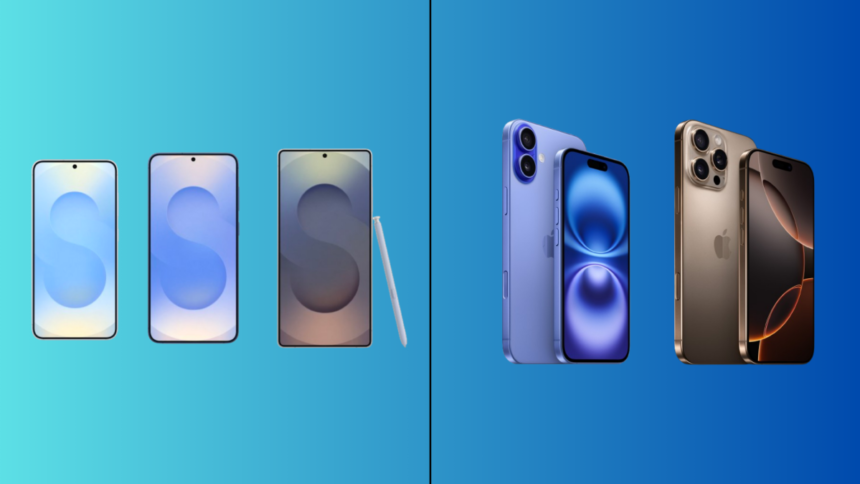Galaxy S25 Series vs. iPhone 16: A Comprehensive Comparison
With the official launch of the Galaxy S25 series, many smartphone enthusiasts may be contemplating a new device. If you don’t have a strong preference between Android and iOS, you might be pondering an important decision: Should you opt for a Galaxy S25, or choose one of Apple’s iPhone 16 models? To aid in your choice, this discussion will delve into the specifications available for the S25 series and align them with the four models within the iPhone 16 lineup.
This analysis will be primarily centered on the theoretical aspects. The iPhone 16 has had time to showcase its capabilities since its release last fall, while Samsung has recently introduced the S25 series, leaving us to await hands-on performance reviews. Nevertheless, examining the specifications can yield insights into the standout features between the two brands. Let’s explore how Samsung’s newest smartphones compare to Apple’s offerings.
Display Features and Dimensions
Focusing first on the Galaxy S25 series, the standard S25 boasts a 6.2-inch “Dynamic AMOLED” display featuring a resolution of 2340 x 1080 pixels. Its dimensions are 146.9 x 70.5 x 7.2 mm, weighing 162 grams. Moving up to the Galaxy S25+, this model features a larger 6.7-inch Dynamic AMOLED display with a sharper resolution of 3120 x 1440, measuring 158.4 x 75.8 x 7.3 mm and tipping the scales at 190 grams. Lastly, the Galaxy S25 Ultra features the largest screen at 6.9 inches with the same 3120 x 1440 resolution, and has the dimensions of 162.8 x 77.6 x 8.2 mm, weighing in at 218 grams.
Next, examining the iPhone 16 series, the standard iPhone 16 offers a 6.1-inch OLED display with a resolution of 2556 x 1179 pixels, marginally surpassing the S25’s resolution. It has dimensions of 147.6 x 71.6 x 7.8 mm and weighs 170 grams. The iPhone 16 Plus shares the same screen size as the S25+, standing at 6.7 inches, while featuring an improved resolution of 2796 x 1290. It measures 160.9 x 77.8 x 7.8 mm and weighs 199 grams.
For users interested in the premium models, the iPhone 16 Pro presents a 6.3-inch OLED display with a resolution of 2622 x 1206 pixels, offering a notable enhancement over the standard iteration and the Galaxy S25. It measures 149.6 x 71.5 x 8.25 mm and weighs the same as the 16 Plus at 199 grams. In comparison, the iPhone 16 Pro Max comes with a 6.9-inch display boasting the highest resolution of 2868 x 1320 pixels in the iPhone lineup, although it falls slightly short when stacked against the S25 Ultra’s resolution. The Pro Max has dimensions of 163 x 77.6 x 8.25 mm and weighs 227 grams.
Internal Specifications
This year, Samsung has maintained consistency in its hardware selection: all models within the S25 series are powered by an octa-core Snapdragon 8 Elite processor built on a 3nm process, paired with 12GB of RAM. The standard S25 provides options of either 128GB or 256GB of internal storage, while the S25+ and S25 Ultra come with either 256GB or 512GB configurations. Battery capacities vary, with the S25 housing a 4,000 mAh battery, the S25+ offering a 4,900 mAh battery, and the S25 Ultra equipped with a substantial 5,000 mAh cell.
On the Apple side, both the iPhone 16 and iPhone 16 Plus leverage the A18 chip, which includes a six-core CPU, a five-core GPU, and a 16-core Neural Engine. In contrast, the iPhone 16 Pro and Pro Max benefit from an enhanced A18 variant featuring an additional GPU core for improved performance.
Camera Capabilities
Photography tends to be a significant consideration for users when evaluating new smartphones. Although real-world testing results are awaited, the current specifications present an interesting comparison. The Galaxy S25 and S25+ come equipped with a triple camera setup: a 12MP ultra-wide (ƒ/2.2), a 50MP wide (ƒ/1.8), and a 10MP telephoto offering 3x zoom (ƒ/2.4). Meanwhile, the S25 Ultra boasts a more advanced quadruple-camera system with a 50MP ultra-wide (ƒ/1.9), a remarkable 200MP wide (ƒ/1.7), alongside the same telephoto options as the S25 and S25+ but with the addition of a 50MP 5x telephoto lens (ƒ/3.4). All three models feature a 12MP front camera (ƒ/2.2), with the Ultra’s variant including auto-focus.
Turning attention to the iPhone 16 series, the standard and Plus models include a dual-camera system featuring a 48MP wide (ƒ/1.6) and a 12MP ultra-wide (ƒ/2.2). Apple promotes the capability to capture 12MP telephoto images using the wide sensor. The Pro models also include the 48MP wide camera, but with a slightly modified aperture of ƒ/1.78, accompanied by a 48MP ultra-wide (ƒ/2.2). They share the same telephoto shot capabilities while introducing a 12MP 5x telephoto lens (ƒ/2.8) unique to these models. All variations of the iPhone 16 come equipped with a front-facing 12MP camera (ƒ/1.9) that features auto-focus.
Available Color Selections
When it comes to aesthetics, Samsung offers a cohesive color scheme across the S25 and S25+. Buyers can choose from options including Silver Shadow, Navy, Icy Blue, or Mint. Additionally, the S25 has four exclusive “titanium” shades: Titanium Black, Titanium Grey, Titanium Whitesilver, and Titanium Silverblue.
Apple mirrors this strategy by providing uniform color choices for the iPhone 16 and 16 Plus while presenting alternative color options for the 16 Pro and Pro Max. The standard models are available in Black, White, Pink, Teal, or Ultramarine, whereas the Pro series comes in sophisticated hues such as Black Titanium, White Titanium, Natural Titanium, or Desert Titanium.












